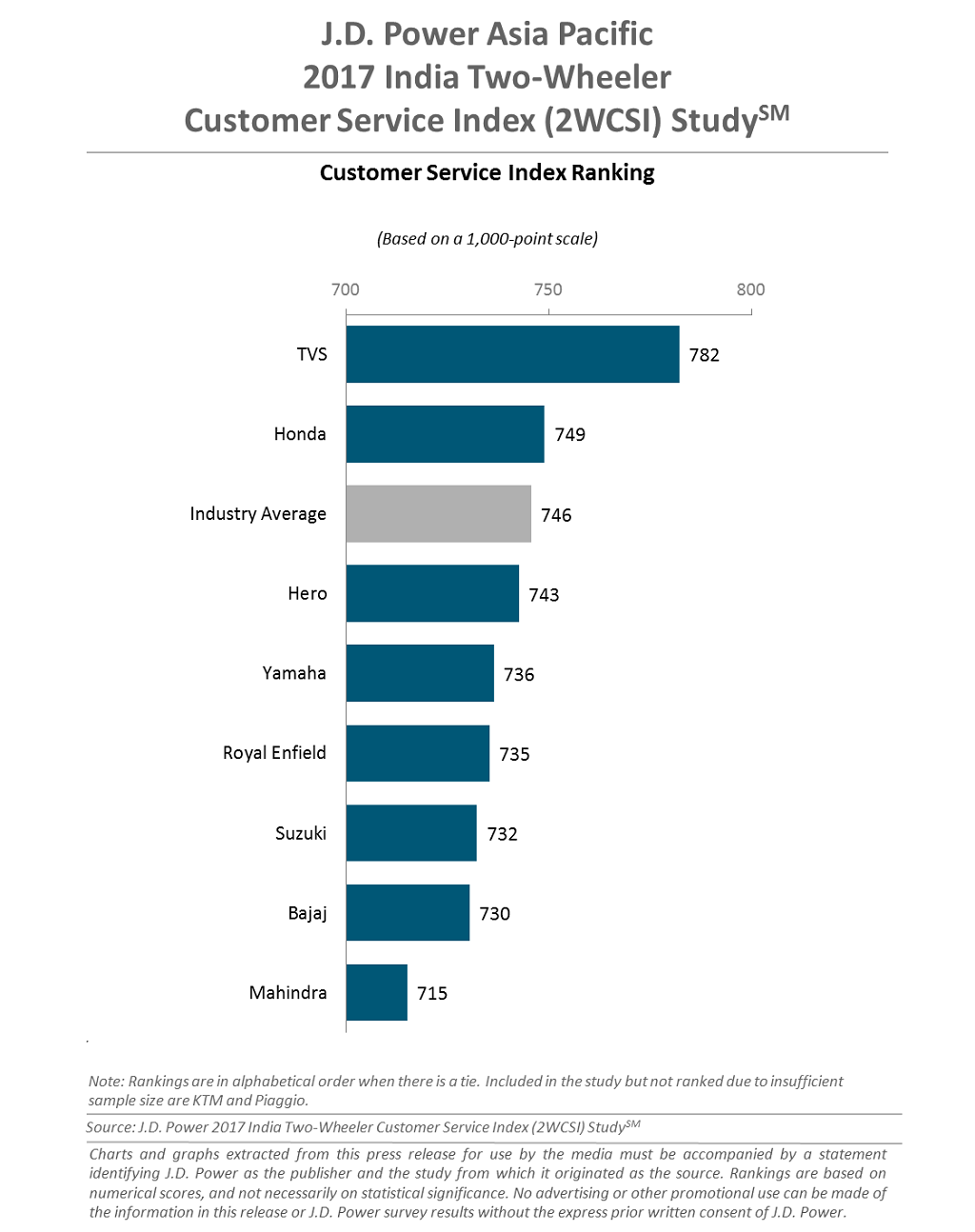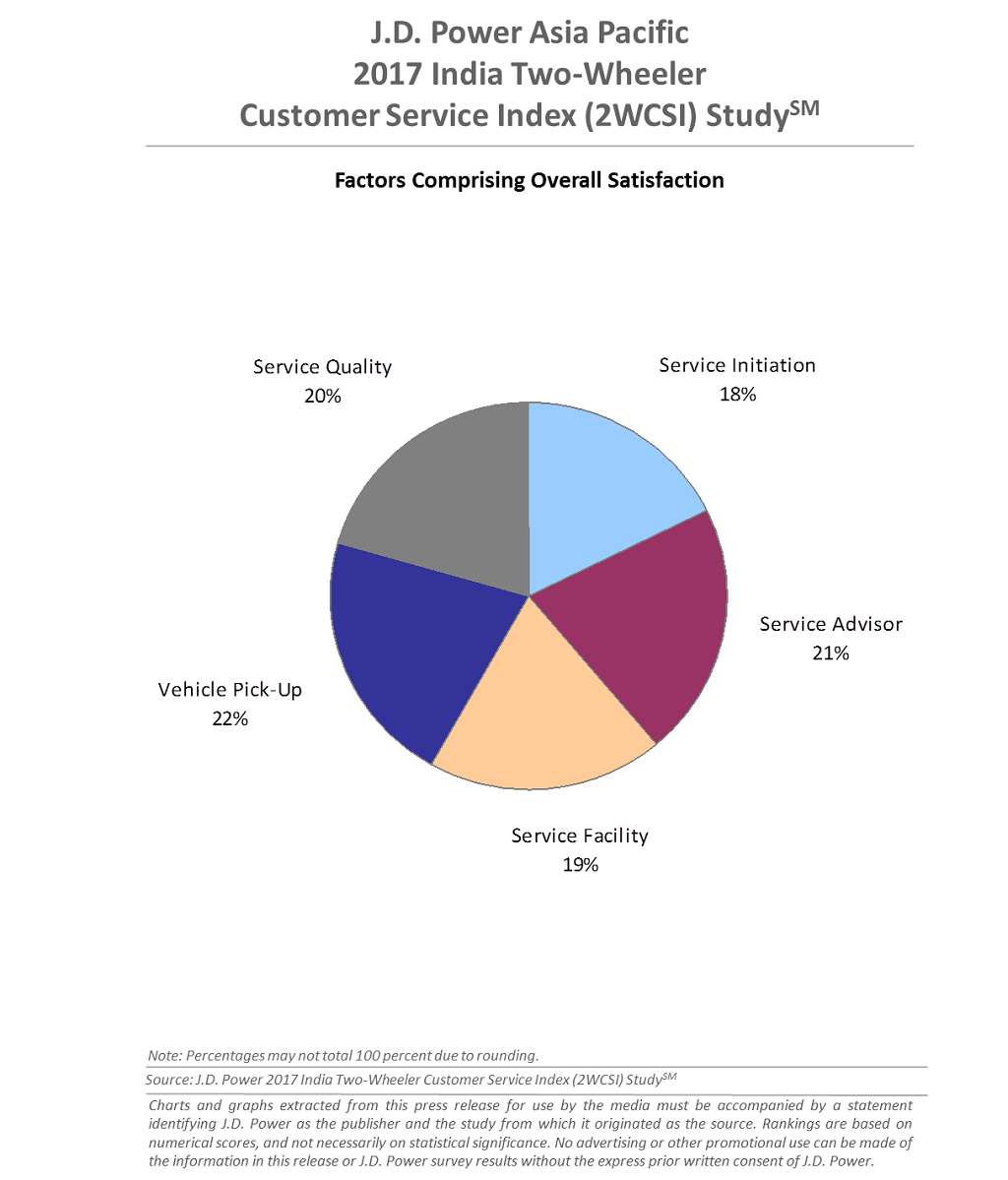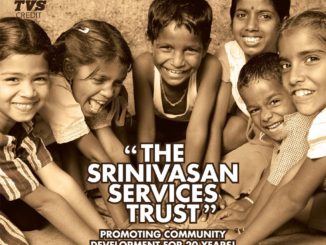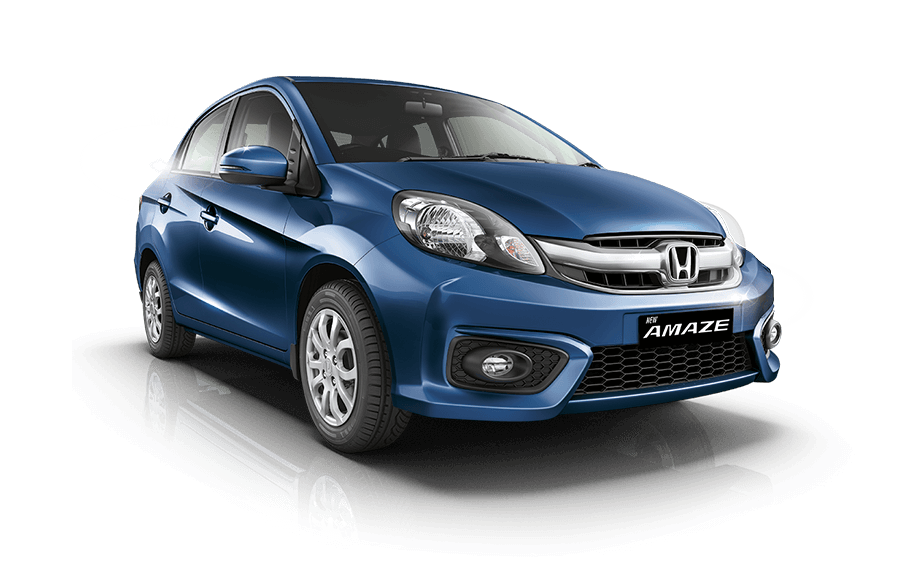Key Highlights:
- TVS Ranks Highest (782) in Customer Satisfaction with Two-Wheeler After Sales Service followed by Honda (749)
- Overall customer satisfaction with two-wheeler after-sales service stood at 746
- Satisfaction highest in service facility (753) and lowest in vehicle pick-up (737)
- Satisfaction higher by 26% among customers who schedule their service than among those who drop by the service
- Satisfaction higher by 21% among customers who were offered express service than among those were not
NEW DELHI: 27 April 2017 — When service dealers effectively communicate with customers at key junctures while servicing a two-wheeler at an original equipment (OE)-authorized service center, overall customer satisfaction notably improves, according to the J.D. Power 2017 India Two-Wheeler Customer Service Index (2WCSI) Study,SM released today.
“While the process-related customer interactions start and end at the service facility, the communication process starts long before a service is scheduled and lasts long after the work has been completed,” said Kaustav Roy, director at J.D. Power, Singapore. “Improved execution of communication standards is crucial not only to improving service satisfaction, but also to the dealer and manufacturer to benefit from increased customer loyalty and advocacy.”
The study, now in its second year, measures customer satisfaction with the after-sales service experience at OE-authorized service centers during the first 12-24 months of ownership. The study measures overall satisfaction in five factors (listed in order of importance): vehicle pick-up (22%); service advisor (21%); service quality (20%); service facility (19%); and service initiation (18%). Overall customer satisfaction is measured on a 1,000-point scale.
“Service dealers are increasingly offering more customer-centric benefits such as pick/drop, the ability to pre-schedule a service visit through an appointment and express service,” said Rajat Agarwal, two-wheeler industry expert at J.D. Power, Singapore. “Owners recognize the benefits of these services and appreciate the actions that dealers and manufacturers are taking to provide for a more convenient and satisfying service experience.”
Satisfaction with the service experience is driven by process and communication. The industry performs strongly on executing process-based activities, with 70% of customers saying their service center performed five or more of the six process standards. But only one in three (36%) say the center delivered on 10 or more of the 12 communication standards during their last service visit.
The study finds that among these two types of activities, communication standards provide greater opportunities for improving customer satisfaction. The 36% of customers who note having received 10 or more communication standards are more satisfied (810) than those who received five or more process standards (774).
Customer satisfaction also can be improved by offering facilities that aid in improving customer convenience when scheduling and executing a service visit. The 14% of customers who were offered vehicle pick/drop at or from their home/office (14%) are more highly satisfied than those who were not (774 vs. 741, respectively).
Following are key findings of the 2017 study:
- Room to improve with convenience: Among the five study factors, satisfaction is highest in service facility (753) and lowest in vehicle pick-up (737).
- Schedule the service: Satisfaction is higher among customers who schedule their service (26%) than among those who drop by the service dealer without an appointment (762 vs. 740, respectively).
- Customers like express service option: Satisfaction is higher among customers who were offered express service (21%) than among those were not (773 vs. 738, respectively).
- Higher satisfaction drives loyalty and advocacy: Highly satisfied customers are more likely to revisit an authorized service dealer even after the warranty period expires. Nearly thrice as many highly satisfied customers (overall satisfaction scores of 859 and higher) say they “definitely would” revisit the service dealer for post-warranty service (70%), compared with only 22% of highly dissatisfied customers (scores of 656 and lower). Additionally, service experience was also found to have an effect on brand advocacy. Nearly four-fifths (79%) of highly satisfied customers say they “definitely would” recommend their two-wheeler make to friends and family, compared with only 32% of highly dissatisfied customers.
Study Rankings
TVS ranks highest in customer satisfaction with a score of 782, performing particularly well in all five factors. Honda ranks second with a score of 749. Overall customer satisfaction with two-wheeler after-sales service is 746. In the two-wheeler segments, the customer satisfaction index (CSI) score averages 750 for scooters and 744 for motorcycles
The 2017 India 2WCSI Study is based on evaluations from 7,310 two-wheeler owners in 45 cities across India. These owners purchased a new two-wheeler between November 2014 and March 2016 and had a service experience within three months of evaluation. The study was fielded from November 2016 to March 2017.
About J.D. Power in the Asia Pacific Region
J.D. Power has offices in Singapore, Bangkok, Kuala Lumpur, Beijing, Shanghai and Tokyo that conduct customer satisfaction research and provide consulting services in the automotive, information
technology and finance industries in the Asia Pacific region. Together, the six offices bring the language of customer satisfaction to consumers and businesses in Australia, China, India, Indonesia, Japan, Malaysia, Philippines, Taiwan, Thailand and Vietnam. Information regarding J.D. Power and its products can be accessed through the Internet at www.india.jdpower.com.





